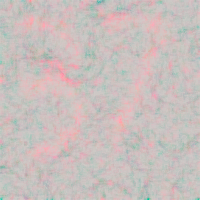How do you sell margarine - stodgy, wholesome margarine - to today's kids? How do you even get their attention in a supermarket saturated with gimmicks and product extensions? "They're always looking for something exciting," says Parkay spokeswoman Gwen Stansu. One answer: color.
"We knew we wanted to introduce a color product. It's been a big trend with kids since the blue M & M," says Stansu. So Parkay tried out margarine in blue, pink, green and purple. "When we tested four different colors in focus groups, kids had a blast." What Parkay didn't expect was that when electric blue and shocking pink margarine emerged as clear favorites, many girls chose blue, and boys even picked pink. Has the boy-blue, girl-pink rule finally been struck down?
Perhaps. If so, it's not the only instance of social and demographic trends altering the color landscape of America. Marketers know that colors have the power to create brand imagery and convey moods. They also know it's essential to take demographic differences into account when selecting a brand's plumage, because colors are accepted by different ages, genders and ethnic groups in different ways.
A nationwide poll conducted by New York City-based BuzzBack and commissioned by American Demographics found clear shifts in taste due to the ways sex, ethnicity and age influence color preferences. A relaxation of color alignments associated with gender, the increased prominence of ethnic groups with different color traditions, the aging of the Baby Boom generation and the growing influence of their offspring, are bringing about broad changes in the palette U.S. consumers find appealing.
"The bottom line is that color preferences are really about demographics," says Jill Morton, CEO of Honolulu-based consulting firm Colorcom. "And it's not a fixed situation either, because our color preferences change over time."
Traditionally, men and women have had different tastes in color, with women drawn to brighter tones and more sensitive to subtle shadings and patterns. The differences are attributed in part to biology, since females see color better than males do (color blindness is 16 times more prevalent in men), and in part to socialization, with girls more likely to be steered toward coloring books and art supplies. American men - compared with Europeans - have traditionally avoided brighter, more complex and warmer hues in favor of darker, richer neutrals and blues, says Kathy LaManchusa, a color trend strategist for companies such as Kmart, Motorola and Philip Morris.
Now, gender seems to have less impact on choices. The American Demographics/BuzzBack survey found that men and women agree on exterior house paint colors; the main exception being the top male choice, white (36 percent would paint their next house white versus 25 percent of women), and the female favorite, beige (35 percent of women versus 29 percent of men). Convergence is also apparent in car colors. The survey also found both men and women choose blue, silver and black cars over white, yellow, red or green. "We would expect men's and women's tastes to be very different," says Christine Dickey, color and trim manager of the corporate strategic and product planning group at Toyota Motor Sales USA. "But contrary to our expectations, today there are surprising similarities in what men and women want in exterior paint colors for cars."
Gender differences are fading even more among those under 30. Says Leatrice Eiseman, director of the Pantone Color Institute and author of The Pantone Guide to Communicating with Color (Graphix Press, 2000): "Ten years ago, it was considered very hard to sell purple to males. It was a female color. But graphic and fashion designers have thrown away the notebook. Today, a guy will go out and buy a purple fleece jacket."
Why the change? First, says Eiseman, previously rigid gender roles have loosened up, and the stigma formerly attached to women who stick with charcoal gray or men who opt for softer shades has receded. Another influence, she says, is the world of sports, where aggressively masculine men do wear uniforms with teal and purple, instead of the primary colors that once reigned supreme.
"I believe that the old paradigm of girls are girls and boys are boys is being replaced by much more crossover in terms of color," says Richard Brandt, executive creative director of San Francisco-based brand consultancy Landor Associates. "But it depends on context. You can't put GI Joe in pink. But can Diesel do pink men's clothing? Absolutely."
Designers say younger men are more likely than their fathers to buy hot pink ski gear, and age affects color preference in other ways too. Margaret Miele, assistant professor of psychology at the Fashion Institute of Technology in New York City, says that as we get older, our eyes mature and our vision takes on a yellow cast. "You can see this in the work of Monet," she says. "In his later years, his paintings became much more yellow." Color looks less bright to older people, so they gravitate to white and other bright tones.
The American Demographics/BuzzBack survey found 10 percent of people 55 years and older want the brightness of a white car, compared with 4 percent of 21- to 34-year-olds and 2 percent of teens. Lexus, which skews toward older buyers, makes sure that 60 percent of its cars are light in color.
Conversely, older people tend to see very dark colors poorly. "In urban design right now, it's popular to use black granite in kitchens," Miele says. "That's great if you're in your 20s or 30s, but by the time you're 45, you won't be able to notice when things have spilt."
Color preferences of younger consumers are also influenced by the cultural context in which they come of age. "Each generation has its own history," says LaManchusa. "They grew up with different values and ideals, were exposed to different cultural trends and ethnic influences. Today, people are surrounded by many more cultures, which makes younger generations more open to cultural influences, and comes out in color preferences a great deal."
Although young people are typically more open than their elders to experimenting with color, kids today are exposed to an even wider palette from an early age. Crayola crayons come in 120 different hues, and advanced computer graphics offer a remarkably extensive selection, says Miele. That makes 'tween and teen preferences unusually sophisticated (in color theory, "sophisticated" describes a color created by a complex mixture of pigments, e.g., deep maroon). Preferences run to offbeat combinations and color effects such as glitter, translucence, pearlescence and metallics.
Color experimentation even extends to foods, which have well established color associations: light blue and pink with sweetness, white with purity. But today, young people's eclectic tastes and yearning for novelty have led to startling foodstuffs like Heinz's "funky purple" and green ketchup lines, which, with $23 million in sales since introduction, helped boost its ketchup sales 14 percent in the past year.
When Landor Associates remade Yoo-hoo back in 1999, playing with color proved to be the way to win teen boys. The challenge was to jump-start Yoo-hoo, a languishing brand packaged in a clear glass bottle with yellow wraparound label. Landor tested a number of cosmetic tweaks, from funky graphics to pictures of kids on skateboards. Says Landor's Brandt: "Although those things were right in line with Gen Y [ages 8 to 25] and they liked them, they didn't react nearly as much as when we broke the rules altogether." Landor reworked the package completely, introducing an oversized logo and coloring the bottle itself with a punched up yellow. "When the whole bottle went yellow, they loved it," Brandt says.
When it comes to car colors, the American Demographics poll found that almost 4 in 10 people 55 years and older prefer blue, while fewer than 1 in 4 teenagers do. Thirty-five percent of teens say they'd make their next car silver, compared with only 17 percent of 35- to 54-year-olds. Christine Dickey of Toyota says that in focus groups, buyers under 35 say they consider metallics as luxurious and futuristic.
The trend toward brighter and more complex colors (i.e. created through a mixture of multiple tones, often with special effects such as translucence or metallic sheen) also reflects the increasingly multicultural makeup of the country. Ethnic differences arising from cultural, religious and historical experiences are also a major influence on color preferences. Blacks, for example, tend to be adventurous with color. "Though it's not true that they just want bright colors," says Mimi Cooper, vice president of Oak Park, Ill-based Cooper Marketing Group. "If chartreuse is the hot color, they want chartreuse; if brown is hot, they want brown."
African Americans, some researchers find, are drawn to strong, saturated color, often in the red, yellow and brown families, a preference that seems to be rooted in their African heritage. Jill Morton of Colorcom found that while working at the University of Architecture at the University of Hawaii, students from Africa constantly worked with sandy hues, primarily burnt oranges and browns.
Some such tastes are also based on environmental factors. A preference among Hispanics for bright colors is a reflection of the intense lighting conditions in Latin America, since strong colors keep their character in strong sunlight. (By contrast, in northern climates, these colors can appear harsh). "When marketing to the Hispanic population, one would want to warm-tone the palette very much," by adding yellow and red tones, says Margaret Walch, director of the Color Association of the United States, the country's oldest color forecasting service.
Hispanics veer toward warm colors, but variations do exist. When it comes to apparel, Mexicans are more traditional (i.e. reds, blues, black) and Puerto Ricans are drawn to livelier colors (i.e. pinks, purples). In Florida, a Cuban palette of pastels, flamingo pink, and salmon dominates fashion as well as exterior and interior design. "If I were to get off an airplane in Miami on a sunny day, I would feel out of place in my navy and tweed," says Walch. "One's palette is very often dependent on the light, where people live, how they spend their days."
The Color Marketing Group (CMG), an association of color designers based in Alexandria, Va., sees the Latin influence expanding to the country as a whole. CMG predicts Latin tones will be a major theme in the 2002 palette, resulting in what co-chair Sue Hannah calls "romantic and passionate earth-connected colors," which she says appeal to younger generations in particular, and will spill over to Baby Boomers. "We're seeing a strong influence from the Hispanic market in terms of reds, yellows and oranges, being reflected in consumer products," says Jay de Sibour, president of CMG. "And with globalization, we're seeing more colors from Asia, also in the red and yellow family, as well as from Europe, which has a more classical influence."
The overall result of demographic diversity seems to be a richer and more varied palette of popular color schemes. Not long ago, designers say, a single color trend tended to be dominant at a given moment. In interiors, there was harvest gold and avocado in the late '60s and early '70s, followed by mauve and French blue, then celadon and peach. "In the popular mass market of the past, we would embrace one color scheme, almost to the exclusion of all others," says trend strategist Kathy LaManchusa. But in recent years, four of five major "color stories" have emerged simultaneously. "As we become a nation of minorities, more people are going to want to try out new colors," says Cooper.
That may mean the country will keep getting more colorful. Like the venturesome youth market, Cooper says Baby Boomers - born between 1946 and 1964 - may also veer toward further experimentation. "After you hit 45 or 50, you work harder at being young," she says. "With Baby Boomers hitting their 50s, they're going to want to show how young they are by trying new colors."
Landor's Brandt agrees. When designing colors for a 20-year-old, he says, don't worry about alienating seniors. "Today's 60-year-old was only 40 when MTV exploded. Old people aren't your little granny with a collar anymore. They're vibrant, they're in tune. The days of the old fogey are gone."
color primer
ethnic color
Blue is No. 1 overall, but the second-most popular color varies by ethnic group. Blacks and Hispanics lean proportionately more toward purple, Asians toward pink and whites toward green.
red lingerie alert
Men generally see red as aggressive, while women see it as sexy. Or is that the same thing?
the sky drops
Seniors are almost four times as likely as teenagers to prefer sky blue.
crayon color census
Top 10 colors for kids versus adults.
COPYRIGHT 2002 Copyright by Media Central Inc., A PRIMEDIA Company. All rights reserved.
COPYRIGHT 2003 Gale Group





